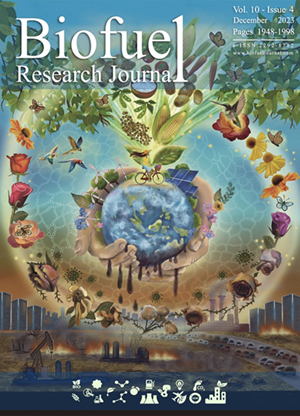Stirred and non-stirred lignin solvolysis with formic acid in aqueous and ethanolic solvent systems at different levels of loading in a 5-L reactor
IF 14.4
Q1 ENERGY & FUELS
引用次数: 11
Abstract
Lignin polymer is biologically and chemically stable and requires highly vigorous conditions for de-polymerization, and subsequent stabilization of the monomeric conversion products to prevent re-polymerization and char production. The Lignin-to-Liquid (LtL) process is a solvolytic conversion of lignin with formic acid. Formic acid has been shown to both catalyze the de-polymerization and supply hydrogen that stabilizes the de-polymerization products. In this paper, lignin from Eucalyptus wood was used as the feedstock, and the LtL-process was performed in both aqueous and ethanolic solvent systems. The experimental variables were different levels of loading in the reactor, stirred and non-stirred conditions, and different reaction temperatures. The bio-oil consisted mostly of phenolic compounds, and the bio-oil yields differed with type of the solvent used, level of loading in the reactor, stirring condition, and operating temperature. More than 55 wt.% of the lignin was recovered as bio-oil at 320 °C at stirred conditions when the reactor was loaded at high level. Overall, the ethanolic solvent together with maximum level of loading in the reactor under stirred condition resulted in the highest bio-oil yield. Elemental balance data for bio-oil and char yields and the molecular composition of the bio-oils were also investigated using, respectively, elemental analysis and GC-MS. Finally, principal component analysis was used as well to systematically explore the relationship between the bio-oil and char yields and the reaction conditions.在5L反应器中,在不同负载水平的水性和乙醇溶剂系统中,搅拌和非搅拌木质素与甲酸的溶剂解
木质素聚合物在生物和化学上是稳定的,需要高度剧烈的条件进行脱聚合,并随后稳定单体转化产物,以防止再聚合和炭的产生。木质素转化为液体(LtL)工艺是木质素与甲酸的溶剂化转化。甲酸已被证明既能催化脱聚合,又能提供稳定脱聚合产物的氢气。本文以桉树木质素为原料,在水溶剂和乙醇溶剂体系中进行了LtL工艺。实验变量是反应器中不同的负载水平、搅拌和非搅拌条件以及不同的反应温度。生物油主要由酚类化合物组成,生物油的产率因所用溶剂的类型、反应器中的负载水平、搅拌条件和操作温度而异。当反应器在高水平下加载时,在320°C的搅拌条件下,超过55wt.%的木质素以生物油的形式回收。总的来说,在搅拌条件下,乙醇溶剂与反应器中的最大负载水平一起导致最高的生物油产率。还分别使用元素分析和GC-MS研究了生物油和焦炭产量的元素平衡数据以及生物油的分子组成。最后,利用主成分分析法系统地探讨了生物油和焦炭产率与反应条件之间的关系。
本文章由计算机程序翻译,如有差异,请以英文原文为准。
求助全文
约1分钟内获得全文
求助全文
来源期刊

Biofuel Research Journal-BRJ
ENERGY & FUELS-
CiteScore
22.10
自引率
1.50%
发文量
15
审稿时长
8 weeks
期刊介绍:
Biofuel Research Journal (BRJ) is a leading, peer-reviewed academic journal that focuses on high-quality research in the field of biofuels, bioproducts, and biomass-derived materials and technologies. The journal's primary goal is to contribute to the advancement of knowledge and understanding in the areas of sustainable energy solutions, environmental protection, and the circular economy. BRJ accepts various types of articles, including original research papers, review papers, case studies, short communications, and hypotheses. The specific areas covered by the journal include Biofuels and Bioproducts, Biomass Valorization, Biomass-Derived Materials for Energy and Storage Systems, Techno-Economic and Environmental Assessments, Climate Change and Sustainability, and Biofuels and Bioproducts in Circular Economy, among others. BRJ actively encourages interdisciplinary collaborations among researchers, engineers, scientists, policymakers, and industry experts to facilitate the adoption of sustainable energy solutions and promote a greener future. The journal maintains rigorous standards of peer review and editorial integrity to ensure that only impactful and high-quality research is published. Currently, BRJ is indexed by several prominent databases such as Web of Science, CAS Databases, Directory of Open Access Journals, Scimago Journal Rank, Scopus, Google Scholar, Elektronische Zeitschriftenbibliothek EZB, et al.
 求助内容:
求助内容: 应助结果提醒方式:
应助结果提醒方式:


